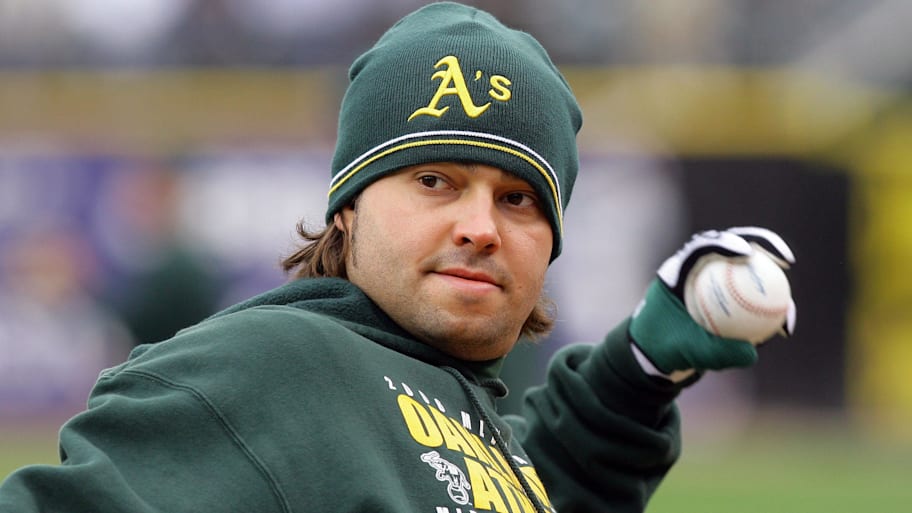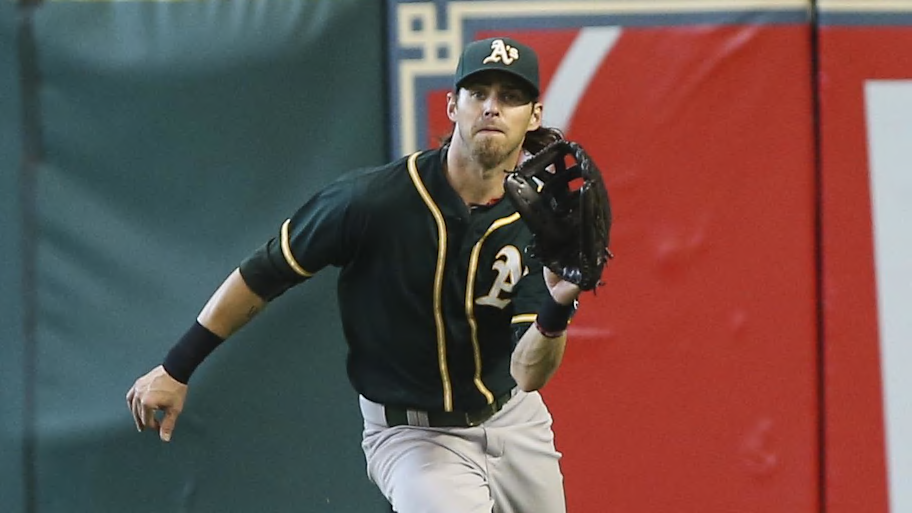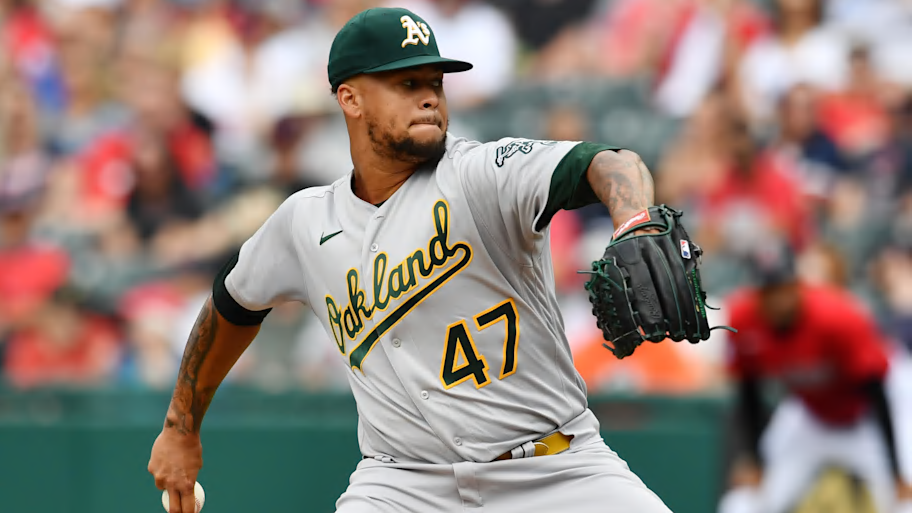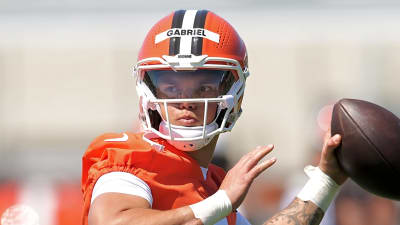
The Athletics have made a lot of trades over the years. That's hardly a secret. At Thursday's Trade Deadline, the team moved closer Mason Miller and starter JP Sears in exchange for the No. 3 overall prospect in baseball Leo De Vries and a slew of pitching prospects. We can't even say that's the most recent trade the A's have made, because again--the A's make a lot of trades.
But one Twitter/X user pointed out that there is a connection between the A's top prospect and the 1998 American League Rookie of the Year, Ben Grieve. Yes, this involves a number of trades, but stick with us.
1. A's Draft Ben Grieve
Grieve was selected by the Oakland Athletics second overall in the 1994 MLB Draft, and after appearing in 24 games in 1997, he played 155 games in '98, primarily in right field, and batted .288 with a .386 OBP and 18 home runs. That was enough to land him the ROY after season's end.
He was still a well above average bat in the following two seasons, and hit a combined 55 home runs while driving in 190 RBI between 1999-2000. He also grounded into a league-leading 32 double plays in 2000. In January of 2001, he was traded to the Tampa Bay Rays in a three-team deal that brought in Cory Lidle, Johnny Damon, and Mark Ellis.
2. A's Trade Grieve in deal that lands Johnny Damon
Damon played with the A's in '01, coming off a season where he received down-ballot MVP votes with the Kansas City Royals. While he didn't finish in the MVP voting in '01, he did score over 100 runs with the club and was a solid piece of the team's offense. When he ended up signing with the Boston Red Sox in free agency, they had to give the A's a compensatory pick in the 2002 MLB Draft.
You may also know it as the "Moneyball Draft." While the results overall weren't the best for the A's, the pick they got from Boston ended up landing them Nick Swisher with the 16th overall selection.
3. A's use comp pick from Red Sox to select Nick Swisher

Swisher made his MLB debut in 2004, and was a key piece of the club during the 2005-07 seasons. In that span, he hit .251 with a .361 OBP with a total of 78 home runs and 247 RBI. The A's weren't a postseason contender during that span, unfortunately, so ahead of the 2008 campaign they ended up trading him to the Chicago White Sox.
The A's have had some franchise-altering deals with the White Sox over the years, later landing Chris Bassitt and Marcus Semien in exchange for Jeff Samardzija. In this 2008 deal, they added Swisher in exchange for reliever Fautino De Los Santos, starter Gio Gonzalez, and outfielder Ryan Sweeney.
4. A's trade Swisher to White Sox, get Ryan Sweeney
Admittedly, this is where things start to rely on secondary pieces of deals to make it all the way to the end, but there is still a through line that we're going to follow.
Ryan Sweeney is the piece of this trade that we want to focus on. The former second rounder spent four seasons in Oakland and was a roughly league average hitter overall, but his OPS+ sat at 91 following the 2011 campaign. With the A's not making a postseason since 2008, the team was once again ready to move some pieces around.
This time, they called up the Red Sox directly, offering Sweeney and the 2009 AL Rookie of the Year, Andrew Bailey, who is now Boston's pitching coach. In exchange, the Sox sent back Miles Head, Raúl Alcantara, and Josh Reddick.
5. A's trade Sweeney (and Bailey) to Boston for Josh Reddick

Reddick had a career year with the A's in 2012, and was a big part of why the club surprised everybody en route to winning the AL West on the final day of the season. For many fans in Oakland, that will be the season that they cherish forever. Reddick hit 32 home runs that year after getting regular playing time, and finished 16th in the MVP voting while earning a Gold Glove for his play in right field.
His importance to the offense diminished over the years, with breakouts from Brandon Moss and Josh Donaldson (Yoenis Céspedes was already a star). The A's continued making the postseason through 2014, where they were eliminated in the Wild Card Game by the Kansas City Royals.
Following that season, the A's made a slew of trades, but Reddick remained on the roster until the 2016 Trade Deadline. He was packaged with Rich Hill and shipped down to the Los Angeles Dodgers at the beginning of August, and one of the players the A's received in that deal was Frankie Montas.
6. Josh Reddick traded to Los Angeles for Frankie Montas

Montas spent six seasons in green and gold, totaling a 3.70 ERA, but when he was on and that splitter was working, he looked like one of the best pitchers in the game. In 2021, he put up a terrific season, posting a 3.37 ERA across a career-high 187 innings.
After failing to make the postseason in '21, the A's traded away Matt Chapman, Matt Olson, Sean Manaea and Chris Bassitt, and waited until the deadline to move Montas. They found a trade partner in the New York Yankees on August 1, moving Montas and Lou Trivino in exchange for Ken Waldichuk, Luis Medina, Cooper Bowman and JP Sears.
7. Montas traded to the Yankees
As you have likely pieced together now, it was the addition of Sears to the roster that is the connecting piece to Leo De Vries. On Thursday, the A's included Sears in what is coming to be known as the "Mason Miller trade" in order to land De Vries, along with Braden Nett, Henry Baez and Eduarniel Nuñez.
8. Sears and Miller land in San Diego for De Vries
With the A's making so many trades over the past two decades, there have been connections to the past with a number of players on any given roster. J.T. Ginn is the result of the A's trading Chris Bassitt to the New York Mets, and Bassitt landed in Oakland because of the previously mentioned Samardzija deal.
The A's current roster doesn't have too many deeper trade trees like the one outlined today, with a number of the players either being waiver claims, draft picks, or free agent signings. The last crop of big trades also involved players that the A's have drafted, like Chapman and Olson.
That is, unless the A's trade another piece of the return from the Montas deal, in which case, the same through line will be present for any player that comes back in that deal as well.
More must-reads:
- Yankees quickly pull plug on key trade-deadline acquisition
- Cubs president admits trade-deadline gamble 'not looking like a good bet'
- The 'MLB playoff home run leaders' quiz
Breaking News
Trending News
Customize Your Newsletter
 +
+
Get the latest news and rumors, customized to your favorite sports and teams. Emailed daily. Always free!








